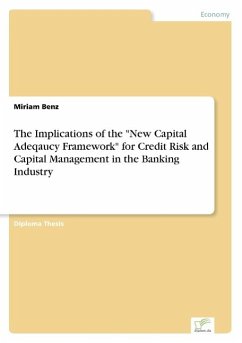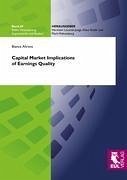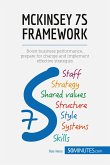Diploma Thesis from the year 2001 in the subject Business economics - Investment and Finance, grade: 1,0, European Business School - International University Schloß Reichartshausen Oestrich-Winkel (unbekannt), language: English, abstract: Inhaltsangabe:Abstract:
In their role as financial intermediaries, banks have the inherent task of assuming risks. This statement follows Diamond s model (1984) that financial intermediaries exist because they have a comparative advantage in the production of private information. Higher competition and complexity as well as a riskier environment however have increased the importance of managing and controlling one of the banks core risks: credit risk. Before analysing the implications on specific credit risk instruments, the thesis will describe the relevant content of The New Basel Capital Accord and explain the general context of credit risk and capital management within a bank. An analysis of the implications of The New Basel Capital Accord implies the question of how the new incentive structures will modify credit risk and capital management activities within banks and shape the competitive environment of the banking industry. More specifically, it will be investigated how the significance and type of credit risk and capital management will change and what effect The New Basel Capital Accord will have on the development of credit risk measurement instruments. The paper will also describe the impacts of the new Accord on the market for credit derivatives and securitizations and on the structure of these transactions. Moreover, it is important to consider how the scarce and essential resource capital will be affected and what potential conclusions can be drawn.
The thesis will show that The New Basel Capital Accord is a major step forward in banking regulation that will better align regulatory and economic capital. It will encourage the usage of internal rating approaches, credit derivatives and securitizations.It will also influence capital allocation and lead to an extended use of active portfolio management. As a consequence of changed incentive structures the analysis will indicate that The New Basel Capital Accord will be an important driver for the advancement and improvement of credit risk measurement and internal credit risk models.
Inhaltsverzeichnis:Table of Contents:
Table of FiguresII
Table of EquationsIII
Table of AbbreviationsIV
1.Introduction1
1.1Motivation1
1.2Outline2
1.3Definitions4
2.Current Basel Accord and The New Basel Capital Accord in comparison5
2.1Current Basel Accord in practice5
2.2Merits and weaknesses of the current Basel Accord6
2.3Objectives of The New Basel Capital Accord 7
2.4Key Content of The New Basel Capital Accord 8
2.5Proposed Approaches for Credit Risk Measurement11
3.Credit Risk and Capital Management17
3.1The state of Credit Risk and Capital Management17
3.2Credit Risk and Capital Management Instruments19
3.2.1Internal Ratings19
3.2.2Credit Risk Models21
3.2.3Credit Derivatives and Securitizations24
4.Influences of The New Basel Capital Accord on Credit Risk and Capital Management26
4.1Motivation for Credit Risk and Capital Management26
4.2Competitive Effects28
4.3Impact on Credit Risk and Capital Instruments31
4.3.1Rating Issues31
4.3.2Credit Derivatives32
4.3.3Securitizations35
4.3.4Portfolio Management37
4.4Impact on Credit Portfolio Models39
4.4.1Significance of Credit Risk Models in Credit Risk Management39
4.4.2Infrastructure41
4.5Impact on Capital Management42
4.5.1Cost of Capital42
4.5.2Bank s Lending Behavior45
5.Conclusion and Outlook47
Table of Appendices51
Bibliography60
Hinweis: Dieser Artikel kann nur an eine deutsche Lieferadresse ausgeliefert werden.
In their role as financial intermediaries, banks have the inherent task of assuming risks. This statement follows Diamond s model (1984) that financial intermediaries exist because they have a comparative advantage in the production of private information. Higher competition and complexity as well as a riskier environment however have increased the importance of managing and controlling one of the banks core risks: credit risk. Before analysing the implications on specific credit risk instruments, the thesis will describe the relevant content of The New Basel Capital Accord and explain the general context of credit risk and capital management within a bank. An analysis of the implications of The New Basel Capital Accord implies the question of how the new incentive structures will modify credit risk and capital management activities within banks and shape the competitive environment of the banking industry. More specifically, it will be investigated how the significance and type of credit risk and capital management will change and what effect The New Basel Capital Accord will have on the development of credit risk measurement instruments. The paper will also describe the impacts of the new Accord on the market for credit derivatives and securitizations and on the structure of these transactions. Moreover, it is important to consider how the scarce and essential resource capital will be affected and what potential conclusions can be drawn.
The thesis will show that The New Basel Capital Accord is a major step forward in banking regulation that will better align regulatory and economic capital. It will encourage the usage of internal rating approaches, credit derivatives and securitizations.It will also influence capital allocation and lead to an extended use of active portfolio management. As a consequence of changed incentive structures the analysis will indicate that The New Basel Capital Accord will be an important driver for the advancement and improvement of credit risk measurement and internal credit risk models.
Inhaltsverzeichnis:Table of Contents:
Table of FiguresII
Table of EquationsIII
Table of AbbreviationsIV
1.Introduction1
1.1Motivation1
1.2Outline2
1.3Definitions4
2.Current Basel Accord and The New Basel Capital Accord in comparison5
2.1Current Basel Accord in practice5
2.2Merits and weaknesses of the current Basel Accord6
2.3Objectives of The New Basel Capital Accord 7
2.4Key Content of The New Basel Capital Accord 8
2.5Proposed Approaches for Credit Risk Measurement11
3.Credit Risk and Capital Management17
3.1The state of Credit Risk and Capital Management17
3.2Credit Risk and Capital Management Instruments19
3.2.1Internal Ratings19
3.2.2Credit Risk Models21
3.2.3Credit Derivatives and Securitizations24
4.Influences of The New Basel Capital Accord on Credit Risk and Capital Management26
4.1Motivation for Credit Risk and Capital Management26
4.2Competitive Effects28
4.3Impact on Credit Risk and Capital Instruments31
4.3.1Rating Issues31
4.3.2Credit Derivatives32
4.3.3Securitizations35
4.3.4Portfolio Management37
4.4Impact on Credit Portfolio Models39
4.4.1Significance of Credit Risk Models in Credit Risk Management39
4.4.2Infrastructure41
4.5Impact on Capital Management42
4.5.1Cost of Capital42
4.5.2Bank s Lending Behavior45
5.Conclusion and Outlook47
Table of Appendices51
Bibliography60
Hinweis: Dieser Artikel kann nur an eine deutsche Lieferadresse ausgeliefert werden.








